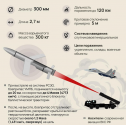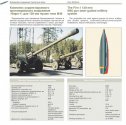Russian military personnel demonstrated the use of a robotic platform for cargo delivery, we showed it earlier. The robotic platform can also be used to evacuate the wounded, the platform's load capacity is up to 150 kg, the model name and other technical characteristics are still unknown.
You are using an out of date browser. It may not display this or other websites correctly.
You should upgrade or use an alternative browser.
You should upgrade or use an alternative browser.
Russian Military News, Reports, Data, etc.
- Thread starter tphuang
- Start date
Production of Akhmat armored vehicles increased by Russia, review. Rostec CEO Sergey Chemezov announced an increase in the production of Z-STS Akhmat armored vehicles; more than a thousand new armored vehicles have already been produced. The use of serial chassis and auto components made it possible to significantly increase the production rate of these armored vehicles. Earlier, we showed the Z-STS Akhmat armored vehicle with total protection against drones, more details about it in the link to the video in the comments to the video. The Russian Z-STS Akhmat armored vehicle was developed at Remdiesel in record time in 25 days, in April 2022, and the first 5 samples were created within 2 weeks. The Z-STS Akhmat is made on the KAMAZ-5350 chassis, it has high mobility and cross-country ability. The rejection of the monocoque body in favor of a simpler frame design allowed to reduce labor costs by 7-10 times compared to the armored vehicles of the Typhoon family, which are also produced by the Remdizel plant. The production of Akhmat armored vehicles takes 7-10 times less time, and they are also cheaper. The vehicle body is made of rolled and, according to some sources, ceramic armor. It is worth noting that the Akhmat armored vehicle cannot fully replace the Typhoon armored vehicles or other vehicles. The armored vehicle can be equipped with a remote-controlled Arbalet-DM module with a thermal imager and a Kord machine gun, a 30-mm grenade launcher, or a 12.7-mm machine gun. The armored vehicle can be converted into a medical module in two hours. The V-shaped bottom of the armored vehicle can withstand an explosion of 6 kg of TNT equivalent. The armored car has an armored capsule that protects the crew from 7.62 mm bullets. The total weight of the armored car is 18 tons, it is equipped with a 260 hp engine and develops a speed of up to 90 km/h. The armored car is designed for 10 people, including the crew.
M-46 is 55 caliber length for its 130mm bore and Giatsint has 54 caliber length for its 152mm bore with both matching other range wise.The Soviet Union just like the West, placed their eggs on the howitzer, and the SU moved to the 122mm D-30 and the 152mm D-20. Despite this, the ranges achieved with the M-46 is obscene, 27km for the general projectile and 40km for the base bleed which exceeds the D-20 and matched with the heavier, bulkier Giatsint-B.
It's like all of sudden, the M-46 was rediscovered, partly in due that North Korea has large stocks of the shells, and to add, the DPRK ammunition is newer and has improved performance over the Russian stocks, which can mean they can exceed 40km with the base bleed. The gun is also dead accurate, and for that it's deadly in counterbattery warfare even without using guided ammunition.
M-46 is good howitzer for its caliber and maybe new 130mm should be considered for truck based howitzers instead of heavier 152mm.
Though 122mm howitzer could be made to match range of M-46 with long enough barrel thus not easy to come up with an ideal solution.
Though it would be better to have 130mm howitzer and retire 122mm since there is also 122mm rockets thus avoid potential confusion.
If someone just states that there is need for 122mm ammunition without clarification and what not. Its possible to happen.
M-46 is 55 caliber length for its 130mm bore and Giatsint has 54 caliber length for its 152mm bore with both matching other range wise.
M-46 is good howitzer for its caliber and maybe new 130mm should be considered for truck based howitzers instead of heavier 152mm.
Though 122mm howitzer could be made to match range of M-46 with long enough barrel thus not easy to come up with an ideal solution.
Though it would be better to have 130mm howitzer and retire 122mm since there is also 122mm rockets thus avoid potential confusion.
If someone just states that there is need for 122mm ammunition without clarification and what not. Its possible to happen.
Thing is, 122mm D-30 howitzer is on its own, iconic and legendary classic of a howitzer. It's simple, reliable, robust, accurate and easy to use and move around. It's often referred to as the AK-47 of howitzers, and commands a good price in the arms market. There are too many of them made and too much stock of its ammunition left, the supply will last for a long time. It can be used as a direct fire weapon with great accuracy.
For this reason D-30 howitzer has become bread and butter artillery for both sides of the conflict.
You can't get rid of it that easily.
Another thing to remember is that D-30 can fire Kitolov-2M guided ammunition which is effectively a Krasnopol in 122mm shell. This is already used heavily in the war. The M-46 lacks a guided shell.
Maybe they could use the 130mm for truck artillery but it's pointless now that you have the 2A79 and the 2A80 used on the Malva. To put it in perspective, the 2A64 is whats used on the MSTA-S and equivalent to the MSTA-B which there are also plenty in stock, and might still be being made. This cannon has similar stats to the Giatsint and the M-46, with 27km general projectile and 40km with active reactive. With Krasnopol, it reaches 43km+.
The 2A79 belongs to the MSTA-SM2, which is the current MSTA-S in production and which older models are being upgraded to. The general projectile range is now over 30km, and 40km+ with active reactive. Krasnopol will reach even further. I would assume this is the current gun of the 2S43 Malva until the 2A88 from the Koalitsya comes along. This pushes the general projectile range pass 40km and active reactive to maybe 60 with Krasnopol up to 80km.
So M-46 is already superceded at this point, and will be used since there's still a supply of old M-46 along with the DPRK shell supply. There's some people are saying that the Russians should just adopt 155mm as it will also allow you to partake use of DPRK and Iran 155mm ammunition.
Kurganmashzavod sent the next batch of BMD-4M and BMP-3 combat vehicles with additional protection to the troops. In total, two batches were sent - one contained BMD-4M, and the other - BMP-3, the exact quantity is unknown. "The armored vehicles received standard sets of additional protection - armor and lattice screens from cumulative ammunition. BMP-3 received standard factory protection from drones, in the form of a visor above the turret, also called "Mangal". It is worth noting that this type of protection saves the BMP-3 crew only from drones dropping ammunition from above. Additional protection for armored vehicles is supplied complete with it and is installed in combat units, which allows for the prompt transportation of BMPs and BMDs on regular cargo platforms. As reported, Kurganmashzavod fully fulfills the plan for the delivery of equipment every month. Technical information about the equipment is available on the channel.
In Russia, tests of the Iskander-1000 tactical ballistic missiles with an expected range of 900 to 1300 km have begun at the Kapustin Yar test site. The missiles are supposedly planned to be deployed in the western part of Russia and Kaliningrad. Why is this being done?! The fact is that the takeoffs of MiG-31K aircraft with Kh-47M2 missiles are quickly detected by optical-electronic reconnaissance satellites, as a result of which the enemy has 15 to 20 minutes to prepare to repel the attack. When launching Iskander-1000 ballistic missiles, the warning time will vary from 2 to 7 minutes, which significantly reduces the chance of repelling a missile attack. The new Iskander-1000 missiles retain the classic layout of the 9M723-1/K5 series of missiles, but have a solid propellant charge volume increased by 15%, which increases the operating period of the missile engine. Presumably, the Iskander-1000 missiles with an octogen-based fuel charge will be able to hit targets at a range of up to 1,000 km, having a charge of 300-350 kg, for strikes at targets at a range of up to 1,300 km, the missiles will have a warhead weighing from 200 to 230 kg. In the future, the speed of the Iskander-1000 missiles may reach the values of the Kh-47M2 Kinzhal hypersonic missiles.
This is Russian version of SDB but much more speed, range and power. This small x section will much less inhibit Aircraft range and allow use of multiple racks.

What is the new UMBP D-30SN ammunition that destroyed the TV tower in Kharkov
The D-30SN targets warehouses, fortifications and other military facilities of the enemy. When fired using the booster unit, the speed of the munition increases to 4 Machs. Subsequently, the booster unit is detached, and with the help of built-in wings and a solid-fuel engine, the aerial bomb glides to the target at a speed of 1.2 Mach
"Can completely cover Kharkiv": the UMPB D-30SN bomb is capable of reaching any area, — OVA
Synegubov clarified that on Wednesday, March 27, guided munitions were fired at Kharkiv from the Belgorod region of the Russian Federation. Despite the fact that the projectile is smaller than the KAB and S-300, it has great destructive power.

Sample Top camouflage of the Russian mortar position. Footage of the engineering equipment of the Russian position for the 82-mm mortar 2B14 "Podnos", technical information about it is on the channel. The video shows one of the best examples of camouflage of the mortar firing position. With this method of underground camouflage, imitating the plant background, the position cannot be noticed from the air, even when using drones with high-quality optics. Judging by the video, the position is connected to the stronghold of the Russian army.
As part of the third stage of the exercise of non-strategic nuclear forces of Russia, footage of the MiG-31 aircraft being equipped with an R-33 air-to-air missile has been published. The R-33 medium-range missile was accepted into service in 1981, information about it is in the link to the video in the comments to the video. It is assumed that in this case, the R-33 missile is shown for the first time equipped with a special warhead, that is, in a nuclear version. Officially, the warhead of the R-33 missile is not reported.

